Getting the Most From Your CSA + Two Favorite Potato Recipes
This post may contain affiliate links. Please read my disclosure policy.
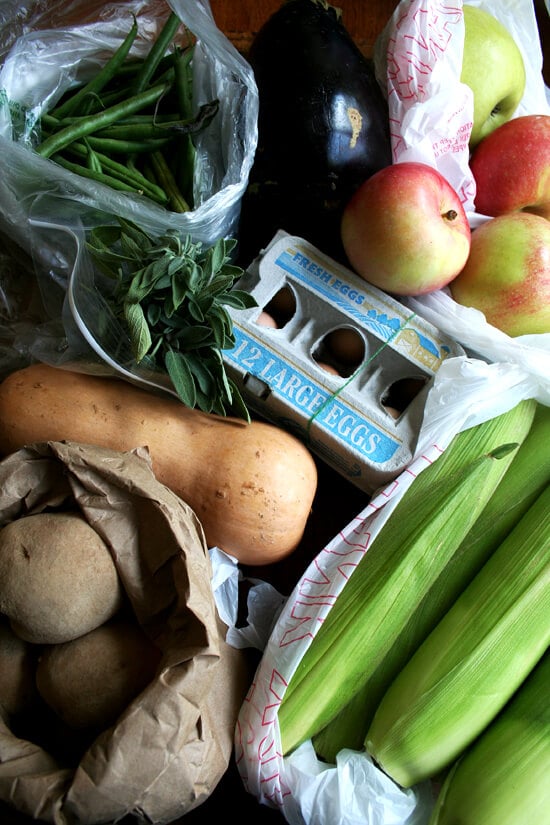
There was a time in my life when subscribing to a CSA had little appeal. I wanted to buy what I wanted to buy when I wanted to buy it. Today, I am happy to have somebody else make the decision for me.
In the past six years, subscriptions to CSAs in eastern Pennsylvania, southern California and northern Virginia have forever transformed how I eat and cook. I have learned to plan meals based on the vegetables I have at hand not the protein. I have learned to appreciate vegetables in their freshest state seasoned with little more than olive oil, salt and pepper. I have eaten more dark leafy greens than I ever imagined.
During this time, too, I have allowed more than one bunch of radishes to shrivel up and rot, a kohlrabi bulb or two to desiccate, and a few bags of okra to mold over. It is painful — shameful — to see these foods spoil. Today, not a morsel of my CSA goes to waste.
Below, I have compiled some things I have learned these past six years that help me utilize my CSA to its fullest potential. If you subscribe to a CSA, I hope these tips might help you in some way. If you are thinking about subscribing, I hope these tips might encourage you to follow through. And finally, if you have anything to add, I hope you’ll leave a note below.
Also, if you are unfamiliar with CSAs, read more about them here.
This is the same batch of produce pictured above, but here I’ve divvied it up (roughly) into side-dish sized portions. Doing this helps me assess the content and allows me to visualize how many meals we should be able to get out of our produce share.
After I divvy up the vegetables, I make a rough schedule for the week and clip it to the fridge. I rarely stick to the schedule and usually prioritize the order by circling one or two of the days.
Tips for Using your CSA:
1. Strategize. Some vegetables tire more quickly than others, so it’s important to use those first to prevent waste later in the week. This is the process I go through every other Thursday, when I pick up my CSA:
• Lay the vegetables out on a table to assess the content.
• Roughly divvy them up into side-dish sized portions.
• Make a rough schedule of meals and stick it to the fridge.
• Circle the days that take priority.
• Before storing vegetables, remove all rubber bands.
• Before storing vegetables, clip greens from radishes, beets, carrots, etc., and save the greens when appropriate (beets, radishes, etc.).
Vegetables that tire quickly:
radishes
carrots
okra
some greens
turnips
eggplant (sometimes)
cucumbers (sometimes)
Vegetables that keep well:
potatoes
sweet potatoes
butternut squash
corn
zucchini/squash
acorn squash
kohlrabi
cauliflower
broccoli
cabbage
garlic scapes
beets (sometimes)
rutabaga
Note: Do not wash your greens ahead of time. I know this is kind of a bummer for some of you, but washed greens, unless they are dried really well, don’t do well in the fridge.
2. Raw vs. Cooked. My favorite family of vegetables from my CSA is the dark leafy green family. Most of these dark leafy greens can be eaten raw — kale, mustard greens, arugula, to name a few. How do you know which ones can be eaten raw? Taste one. If it tastes good raw, eat it raw. I love steamed greens with olive oil and lemon, but a huge batch of greens — one that could potentially feed four people — can wither down to almost a single serving when steamed or sautéed for a long time.
So, when you can, try to eat your greens raw — you’ll get more mileage out of your CSA greens. With this in mind, it helps to know how to make a good salad dressing. I’ve compiled all of my favorite dressings on this page: Salad Dressings & Vinaigrettes. Hearty greens like kale can take a heavier dressing like a caesar; more delicate greens (arugula) do better with something lighter, such as a lemon vinaigrette. Both of these dressings are on the salad dressings & vinaigrettes page.
When you can’t eat your greens raw, however, a quick sauté over high heat does a nice job of not wilting your greens entirely down to nothing. Certain greens, Swiss chard and watercress, for example, taste better (to me at least), when cooked just briefly. Here’s a good little recipe to know:
Wash your chard and leave to drain in a colander. A little water left on the green’s surface is OK — it will provide some welcomed steam. Mince some garlic. Have some red chile flakes nearby. Heat a large sauté pan over high heat. Add some olive oil — a thin layer (maybe a tablespoon or two). Add the greens — careful here, the water from the chard will make it splatter a bit — then add a pinch of kosher salt, the garlic and the crushed red pepper flakes. Let cook for about a minute, then with tongs, start rearranging the greens so they cook evenly. Remove from heat after another minute. The chard will continue cooking as it rests.
3. Equipment. If you’ve ever considered getting a mandoline, now’s the time. A mandoline will turn three small potatoes into a sheet-pan’s worth of thinly sliced coins that will comfortably feed two people. Also, when you season these coins with olive oil, salt and pepper and roast them at 450º for 15 minutes, you might discover your new favorite way to cook/eat potatoes. CSA potatoes, by the way, are unlike any potato you will find at a grocery store. They are so good.
A mandoline comes in handy, too, for slicing up radishes and kohlrabi for salads.
A few other essential tools (for any kitchen, really):
• a few large jelly roll pans for roasting vegetables
• a large cutting board and a good chef’s knife
• a bench scraper — use this to scrape food you’ve chopped up into prep bowls; use this to scrape scraps into a “trash” bowl (which saves time making trips to the trash can); use it to cut dough… the possibilities are endless
• a steamer basket and a large pot to put it in — both of these are handy for steaming green beans, broccoli, corn, etc.
• a few large stainless steel bowls for tossing vegetables with olive oil, for mixing doughs, for mixing pasta or grain salads, etc.
• a large wooden salad bowl — I suppose this one is more of a taste thing… not really essential at all. I just love a large wooden salad bowl, particularly this shape. I visited this shop many years ago and picked up a “defective” one for a fraction of the prices I am seeing online today. These are definitely expensive, but so pretty and handy.
• Many people would say a salad spinner is a superfluous kitchen tool — arguing for paper towels instead — but I love my salad spinner.
4. Supplementing your CSA. If you can make your CSA work without buying any other produce, then keep on doing it (and please email me to tell me your secrets). I find I nearly always have to supplement not only with some additional produce — I cannot get my CSA to stretch the full two weeks — but also with the staples: onions, garlic, shallots and lemons. Ginger is nice to have on hand, too, and herbs are a must: rosemary and thyme this time of year, and chives, tarragon, basil, and cilantro in the spring and summer.
5. Reviving Tired Greens. Sometimes, despite all of your strategical efforts, a bunch of chard might shrivel up in your vegetable drawer. Don’t despair, this trick works wonders: Place your greens in a large bowl and fill it with enough cold water to submerge the greens. Add about a tablespoon of vinegar. Let sit for at least 30 minutes. If after the 30 minutes some of the leaves have not revived, they probably are beyond repair.
6. Whole Grains, Beans, Pasta. If you have on hand some good whole grains (especially convenient are the quick-cooking ones such as quinoa and semi-pearled farro), pasta, or some dried beans (which require some planning), you can turn a couple of carrots, an onion and a few big leaves of mustard greens into a hearty side dish. Add to the mix some cheese or diced, crisped pancetta or a poached egg or some shredded roasted chicken and you have a complete meal. This recipe, made with semi-pearled farro, comes together very quickly and can be adapted to your liking.
7. When In Doubt, Roast. Almost everything can be roasted — radishes, cabbage, kohlrabi, etc. This is what I do: Preheat oven to 450º. Spread vegetables out in a single layer on a jelly roll pan. Season all over with kosher salt and pepper. Drizzle with olive oil and toss to coat. Spread vegetables back out into a single layer. Roast for about 20 minutes, stirring halfway through if you remember.
8. Pickling. Pickling will not help you get mileage out of your CSA in the present moment, but it’s a good thing to know how to do, especially when you find yourself with vegetables you might not be so fond of. I hate to admit it, but I am not the biggest kohlrabi or okra fan. I recently discovered pickle okra, however, which is delicious, and while I haven’t tried pickling kohlrabi yet, I suspect it will work well. With the recent discovery of pickled okra, for the first time ever, I am looking forward to receiving a kohlrabi bulb in my CSA.
9. How To Make a Meal Out of a Bunch of Radishes? I love radishes, but when I see them in my CSA, I find myself saying, “Awesome,” in a less than awesome tone. It’s just hard to make a substantial side dish, even with a mandoline, out of a bunch of radishes. So, when I am organized, I make some bread — this one or this one — break out the good butter and salt, and slice up those radishes on my mandoline. Yes, I am giving you the most unoriginal idea for how to use up those radishes, but there is a reason why good bread, butter, radishes and salt is so widely adored. If you haven’t given this one a go, now’s the time. This is a meal, too, to open up a few tins of sardines, set out a block of cheese, and just nibble away.
10. A Few Staple Recipes.
Pizza. Homemade pizza is such a treat, and it’s a great vessel for sautéed greens, roasted eggplant, raw shaved zucchini, thinly sliced potatoes, etc. With pizza as the main course, a light salad or a few roasted vegetables makes for a nice simple side dish.
Quiche, Crustless or Not. After discovering Tartine’s recipe, quiche (most often crustless these days) has become a staple in our house. This recipe taught me that it is OK to add uncooked greens to the custard. I tend to load our quiches up with chopped raw kale or chard or whatever I have on hand. Quiche is a great high-protein vegetarian entrée, and it is incredibly delicious.
Whole Grain Salads. As mentioned above, having whole grains and dried beans and pasta on hand are really helpful for turning your vegetables into main courses or heartier side dishes. I love semi-pearled farro and make some variation of a farro salad at least twice a week. Here are two ideas for you, but adjust the recipes based on your preferences and the produce you have on hand: Farro Salad with Mustard Greens, Pine Nuts, Roasted Onions & Currants; Farro Salad with Roasted Corn, Red Onion, Red Pepper and Cilantro.
Potatoes. It helps to know a few food potato recipes. When I don’t slice potatoes on my mandoline into coins and roast them, I cook them this way: with a ton of salt, some herbs and a few cloves of garlic in a pot of water brought just to a boil. Find the full method/recipe here: Fingerling Potatoes with Rosemary & Thyme, Crispy or Not.
I also adore this roasted potato salad.
And I have been meaning to post about this Cooking Light “veggie fry” recipe for a long time — it is so good. The picture below features potatoes only — the recipe calls for both potatoes and carrots, which are also delicious — and I suspect parsnips would do well under the same treatment.
PrintVeggie Fries
- Total Time: 33 minutes
- Yield: 4-6 servings
Description
Source: Cooking Light
Ingredients
- 2 tablespoons yellow cornmeal
- 1/2 ounce Parmigiano-Reggiano cheese, finely grated (about 2 tablespoons)
- 1 pound Yukon gold potato, cut into wedges
- 1 1/2 pounds baby carrots with tops, peeled and trimmed
- 2 tablespoons olive oil
- 1/4 teaspoon kosher salt
- 1/4 teaspoon freshly ground black pepper
Instructions
- Place a large baking sheet in oven. Preheat oven to 450°.
- To prepare veggies, combine the cornmeal and cheese in a small bowl, stirring well. Place potato and carrots in a large bowl. Drizzle vegetables with 2 tablespoons oil. Sprinkle vegetables with 1/4 teaspoon salt and 1/4 teaspoon pepper; toss. Sprinkle the cornmeal mixture over vegetables; toss. Arrange vegetables in a single layer on preheated baking sheet; bake at 450° for 15 minutes. Turn vegetables over; bake an additional 8 minutes or until golden and tender.
- Prep Time: 10 minutes
- Cook Time: 23 minutes
Roasted Potato “Chips”
- Total Time: 20 minutes
- Yield: 2 servings
Ingredients
- 3 small potatoes (or however many you like)
- olive oil
- kosher salt
- freshly ground pepper
Instructions
- Preheat the oven to 450º. Slice potatoes thinly on a mandoline (1/8- to 1/4-inches thick). Lay the slices on a sheetpan. Drizzle with olive oil. Season all over with salt and pepper. Toss, then lay potatoes back into a single layer. Place in the oven and cook for about 15 minutes, checking after 10. If they are browning unevenly after 10 minutes, turn the oven down to 400º.
- Prep Time: 5 minutes
- Cook Time: 15 minutes
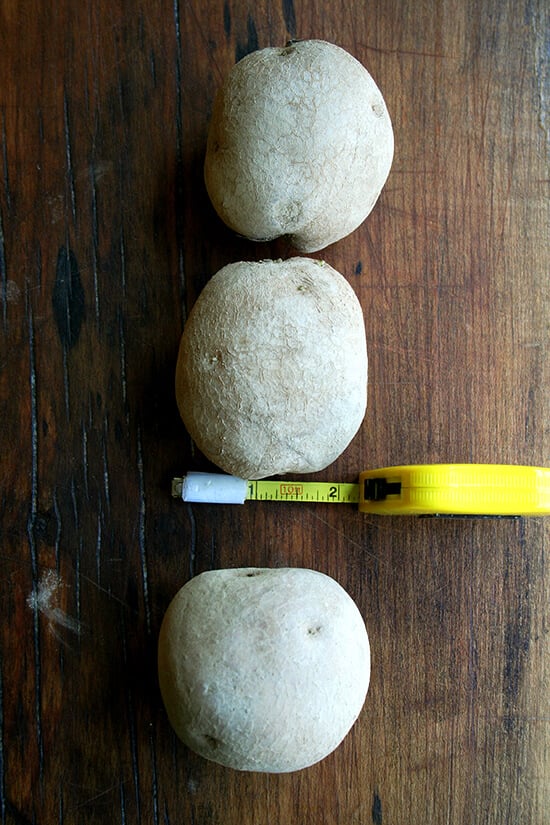

This post may contain affiliate links. Please read my disclosure policy.

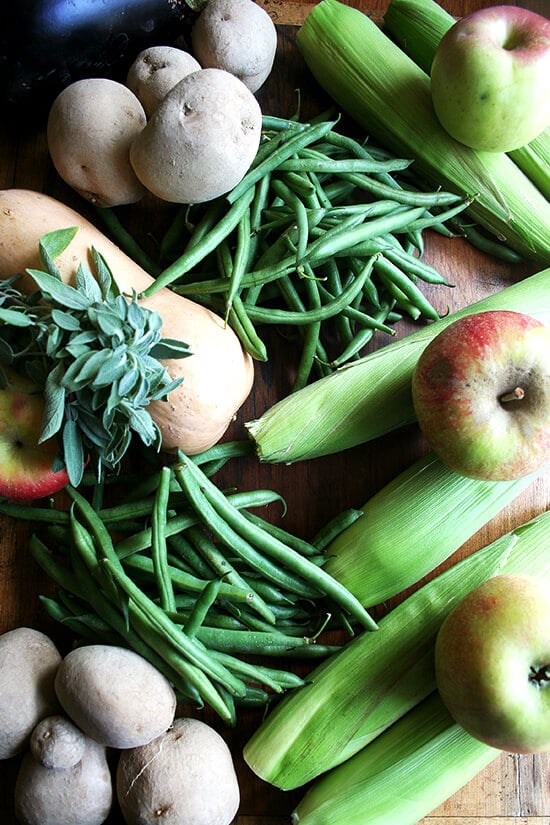
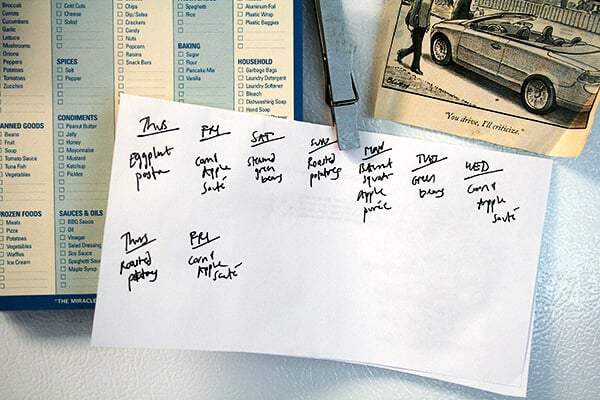





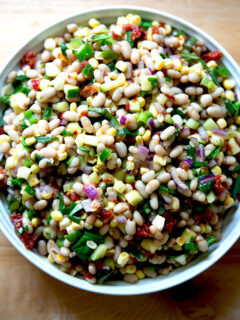




38 Comments on “Getting the Most From Your CSA + Two Favorite Potato Recipes”
Great tips! thank you
this was a wonderful post and i passed it along to several friends! i’ve been wanting to join a CSA in new york for a while now, but they are rather pricey here and I haven’t found a friend to split the cost. hopefully this will help motivate me to finally do it!
Abby — I hope it does!
this is a great post! do you have any suggestions for the best way to store veggies?
Rebecca, I tend to store most of my veggies in the bottom drawer of my fridge. It is important to keep things like lettuces or greens away from the coldest section of the fridge, because if the leaves freeze, they’re basically done. As I mentioned, I always snip elastic bands, remove greens from carrots, beets, etc, and I don’t wash ahead of time because I haven’t had luck with doing so. These are vegetables I never stick in the fridge: tomatoes, onions, garlic, shallots, potatoes, sweet potatoes, butternut squash, acorn squash. If I think of others, I will follow up. My Chez Panisse Vegetables cookbook is a fantastic resource for tips on this sort of thing. I don’t always follow — for instance the book recommends not refrigerating eggplant, but I tried this once, and my eggplant started turning way too quickly. Also, if you have space, I find the bottom shelf of the refrigerator door is a great spot for tucking away super long vegetables — rhubarb, chard, fennel, etc. Hope that helps! Oh also, everything is usually stored in the plastic bag that it arrives in — not sealed airtight, but protected from the air of the fridge.
I can never quite commit to doing a CSA because I never know how I would deal with it, but this is a really useful post and may provide the confidence to finally pull the trigger for next year.
One tip: I use carrot greens to make soup. Italian-esque with rice, white beans and a base of onions, carrots, celery etc. etc. Top with grated parmesan or nutritional yeast. I try to just use the feathery greens for the soup and use the stems when I make broth.
Sarah Ruiz — I had a really good friend in college names Sarah Ruiz, and seeing your post makes me miss her so! Thank you so much for the tip on the carrot greens. Honestly, mine usually go straight to my compost bin… I didn’t know they could be put to seriously good use! Your soup sounds incredibly delicious. Especially this time of year. Yum!
This is the BEST POST EVER! You have almost talked me into doing a CSA… except I never cook for myself, but I am so inspired to take on more veggies! You are a saint, I am posting this for all the world to see!
Thanks, Katykat!
Ali! What a wonderful post. I dont’ have a CSA, but the way I treat the farmers market is a bit like a CSA: I just buy whatever looks good, often way too much of it and inevitably dump it on my counter and stare at it with utter indecisiveness as to what I’ll do with it. I love love love all of your ideas and tips! Thank you! And those potato Chips looks right up my alley.
What is this corn apple saute on your list? I am intrigued. Is it exactly what it sounds like?
Karen — it is so easy. All I do is sauté some onions, remove them from the pan. Add a little more oil or butter, brown the apples, remove them from the pan. Add the corn (again with a little more butter or oil), and once it starts browning, add all of the ingredients back into the pan. I season along the way with kosher salt and fresh pepper. Also, if I have basil or cilantro, I add that in at the end. Sometimes I add a splash of hot sauce at the table, sometimes I don’t. It’s qyick and easy. Oh, you can also add some plumped currants or golden raisins or some toasted pine nuts. The inspiration came from this recipe, which I love: https://www.epicurious.com/recipes/food/views/Catalan-Spinach-1889
You can also fold all of this into some farro or quinoa or whatever grain you have on hand. Hope that helps!
I loved this post but it made me miss my CSA – we used to get one in Australia but haven’t been able to find a real CSA in London only ‘fruit and vege’ boxes which is just not the same thing!
Everyone should try a CSA – the fruit and vege is soo much more tasty and I found that we ate so much more healthy when we were getting one. Do you get a lot of sweet potato in the CSA’s in the US? I was always stumped for how to use up sweet potato as it’s something I would never buy to cook with. But I figured out making sweet potato gnocchi – also a good way to use up any extra potatoes too, it’s great and you can make a whole bunch and freeze them. And then serve them with random vegetable based sauce. It’s perfect! Also I find forcing visitors to carry home handfuls of sweet potato a good ploy to getting ride of them 😛
Explody Full — We do get a lot of sweet potato in our CSAs here. I have the same trouble — I am not the biggest sweet potato fan. I tried the “veggie fry” recipe in this post with the sweet potatoes, and they were good, but not great. I love your idea about making gnocchi! I think that is definitely what I am going to have to try. I love how you just casually say how you’re thinking about whipping up a batch of gnocchi — I don’t make them often enough to feel so comfortable. I do have a ricer, however — do you use a ricer? Do you have any gnocchi-making tips to pass along. I have two sweet potatoes sitting in my vegetable basket, and I think gnocchi is a must. I will report back for sure. Also, I just realized, I have sage from my CSA, too. It’s a must!
Explody Full — Thank you so much!! I can’t wait to follow the instructions on your blog for making gnocchi. They look amazing!
I should try the portion sorting and recipe calendar. I make a list of what I have from the CSA and post it on my fridge. As I finish produce, I check it off which feels satisfying. Having an ingredient list in front of me also helps me plan recipes. Also, I often supplement by purchasing cheese and pasta.
Beastmomma — the ingredient list or meal list is key — it’s crazy how things can just disappear in the vegetable drawer.
alright, HOW did i not know about this lovely space? just stumbled over, from house to haus, and my goodness, what a treat. i’m off to go poke around further in a moment, but wanted to thank you, in particular, for the apple “pancake” and potato fries, both of which will be served up here, shortly.
cheers,
molly
Molly, welcome! And I discovered your site via house to haus as well a long time ago and silly me never subscribed. I am now all set to receive updates via email. Your website is amazing. You are so crafty. I am going to go poke around some more as well. Can’t wait to see more!
Explody Full — so wonderful! Can’t wait to try the recipe. Looks absolutely divine!
I am not one to ever make NYs resolutions but this post has given me the urge to make joining a CSA my resolution for 2013 🙂 love your site – inspiring and yummy!
Emmie — so happy to hear this! We love our CSA, especially the winter months…all those dark leafy greens. Yum! Happy 2013 to you!
This is a wonderful post! I’ve been getting a CSA box (in Australia) for about a year and it has revolutionized my approach to cooking in the same ways you describe. I take basically the same approach – I have a small whiteboard on the fridge and list all the veggies from my box on one half, then compose a list of possible meals to use them all. I erase the veggies as I use them up.
As far as storage goes, I find everything lasts longer in an airtight container, rather than the fridge drawer.
Joanna — hello! Wonderful to hear all of this. You know, I have been thinking that I need to get a wipe board or chalk board or something, because the scraps of paper just get so messy. It’s amazing how much better I am about using my veggies in the appropriate order, when I take the time to make out a little schedule. And thanks for the tip about the airtight container. I think I should start doing that with some of these delicious winter greens we have been getting. I have a feeling they would last longer if they were sealed up a little more tightly. Great tip. I should make a note of that in the post. Thanks for writing in!
It’s a great way to cook and eat, isn’t it? I get so excited opening the box to see what is in there. Especially at the moment as it’s summer here and I had beautiful nectarines in my box this week!
Joanna — so jealous about your summer nectarines! Would die for one of those right now, but I suppose that’s part of the fun of seasons. Indeed, it is such a great way to cook and eat!
I noticed the “not-so-happy” face about radishes in your comments and I must say, I understand. Or at least, I used to understand. I started making radish green pesto this year and I haven’t looked back! I add in a few other basic pesto greens (maybe a little spinach and always some basil, possibly some garlic scapes) and voila! I have saved my radish greens from the composting heap once again! I never use radishes from the grocery store for this recipe because I don’t think they taste good, but other people I know use all radish greens and love them equally. They take a while to pick through, but the satisfaction of knowing how good this food is for me and my family outweighs the time I spend cleaning it. I hope this helps in your endeavors to use all of the food you receive.
Michelle — what a wonderful tip! I am definitely going to try that this winter…the radishes are arriving in droves. Last week, I was actually a good girl and sautéed them with some Swiss chard on the same day we picked up our CSA, but I have not been so good in previous weeks. Radish green pesto is genius. And it can be frozen! Right? That would be so nice to have on hand throughout the winter. Thank you for your nice comment!
Have you ever considered about including a little bit more than just your articles?
I mean, what you say is important and everything.
But think about if you added some great graphics or videos to give your posts more, “pop”!
Your content is excellent but with pics and clips, this blog could undeniably be one of the best in its niche.
Good blog!
Hi, i think that i saw you visited my website thus i
came to “return the favor”.I’m attempting to find things to improve my web site!I suppose its ok to use some of your ideas!!
You mentioned working your meals around the vegetables and that is what I usually do. Being summer, I enjoy fresh the best, but mix it up with raw and cooked.
I am not doing CSA at this time, but good vegies are my focus. Usually organic. Plus I have a few types of frozen organic vegetables for when I might run out of somethings. It really comes in handy.
Alexandra- I’m so happy I came across your blog. I love your style of cooking, especially the way you whip up veggies plus grains into a meal. I have 2 storage tips. For lettuce or mixed baby greens: store unwashed in an airtight plastic container, like the one made by Rubbermaid. Include one paper towel on the bottom and one on the top to absorb any excess moisture. Replace paper towel if it gets damp. The lettuce will last up to 2 weeks. Leafy greens: One rainy season mine came so muddy, I couldn’t bare to put so much dirt into the fridge. I’ve been washing ahead of time ever since. After washing, I put them in the salad spinner, then leave them on a tea towel on the counter to completely dry for an hour. Then I roll them up in a clean tea towel or paper towels and seal them in a plastic container or a plastic bag with a twist tie. The leafy greens last in the refrigerator for up to two weeks. Having them clean makes them easy to use. Hope this helps. All the best, Dana
Dana, hi! Both of these tips are great. It’s funny you mention the paper towels, because I used to buy lettuce at the farmers’ market from this wonderful farm in CA, and they packed the heads in paper-towel lined clamshells — the lettuce kept for weeks! I need to do this more. And the tea-towel-for-an-hour tip is something I need to try. I think getting the leafy greens really dry is key for their longevity. Too much moisture will cause them to tire quickly. Thanks so much for writing in! And thank you for your nice, thoughtful comment.
For the radishes, I like to make a tasty Guatemalan salad called “picado de rabano.” All you do is chop the radishes into very small bits and toss with chopped parsley and lime juice. It’s a delicious salad, though more of a side dish than a main course.
I keep my greens in the crisper drawer, but I’ve found that if I lay a sheet or two of newsprint in the bin before putting the greens in there, they last 3x as long. It’s worth trying! It also makes it easy to clean the bin, just lift the paper out and toss.
Gourmet Mama — love this idea for radishes! Would it be ok to add some diced serrano or jalapeno? I love the idea of making it a little spicy.
Hi Alexandra,
I just love your site! I have found myself going back and back to it again for great recipes and tips (I’m now obsessed with bread crumbs on everything!) I am a new CSA member and have felt so ashamed throwing away decomposing spinach and rotting potatoes – thanks for this post! I have been persuaded and just ordered my very first mandolin. 🙂
A note on radishes – I’m living in France (my husband-to-be is French) and you named my absolute favorite way to eat radishes now – with lots of butter! To be frank, my exposure to radishes before was limited to a tired salad topping so when I moved to France I was amazed at how much more of a center role this vegetable takes. One of the quickest/easiest ways I’ve adopted to eat our radishes is to roughly trim them and pop them on a plate next to some sliced hard salami as an aperitif nibble. Something with the fatty and salty meat followed by the clean bitter taste of the radish… mmmm. Anyway, my point in all of this is that your bread/butter/radish combo is perhaps my favorite way now to eat them – however in France I have learned that many people bypass the bread in the equation completely (I know, shocking.) We’re talking a bowl of radishes on the table where each person serves themselves some. Forks and knives are used to cut them, a slab of butter is placed next to it and a sprinkle of salt next to that. Then, still using fork and knife, they’ll cut off a chunk of butter, spread it onto the radish, dip it into a bit of salt kernels and the whole thing is popped into their mouth – sans bread!
A bientôt!
Jennifer, hi, and thank you for writing in, and thank you for your kind words. Means so much!
I loved reading your note on radishes. My exposure to radishes pre-CSA life was similar to yours, and I never knew how delicious they could be until I tasted a local, in-season radish. The second wave of radishes just arrived in my CSA today, and I couldn’t be more excited to try your ideas: with hard salami (1) and without bread (2) — what a shock to hear this! I love the idea of radishes, butter and salt only. Trying tomorrow. Fun! Thank you again for writing in. Loved reading all of this. Also, I’m completely jealous you are living in France.
Radis au beurre…yum. But a radish and chive sandwich…on buttered homemade bread…was my Dad’s and my favorite sandwich to this day. Now my kid’s…. a little kosher salt, a little fresh pepper and you have a crisp/soft/buttery/sweet/peppery mouthful of perfection. And when your radishes get too peppery (late season), add them to a stir fry. They lose their sharpness but keep the crunch.
Love my CSA—thanks for the ideas putting it to good use! I cope with the greens ASAP—-CSA night is salad night, be it salade nicoise with gorgeous french beans, baby potatoesand tomatoes or a Vietnamese bun eith crispy lettuce, cukes, shredded carrot, lots and lots of basil, mint, lemon verbena and nasturtium for good measure…noodles and sauce of course, but even the teen doesnt miss the meat.